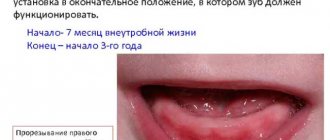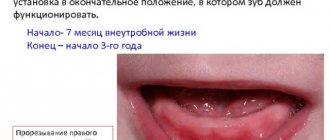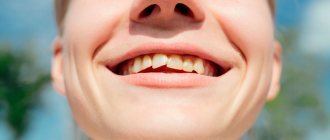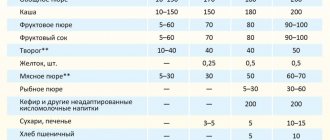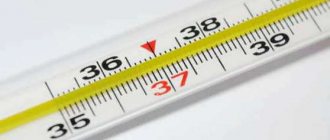Norm or pathology
Can teeth be cut at 3 months? The earliest age for the eruption of the first elements is considered to be three months of age. Dentists consider it normal for the first teeth to appear at 3 months of age. If the incisors appear earlier than the expected period, then the child should be shown to a therapist. The early appearance of elements on the surface of the gums may signal hormonal disruptions occurring in the body.
The appearance of baby teeth on the surface is accompanied by a number of distinctive symptoms:
- Pain in the gums. Because of this, the child puts fists and foreign objects into his mouth. At this moment, it is important for adults to ensure that there are no small toys or objects near the child that could get into the respiratory tract.
- Deterioration of the oral cavity. The gums swell and redden, becoming more sensitive to external irritants. In some cases, due to teething, the child may experience slight redness of the throat.
- Irritability and increased tearfulness of the baby. The symptom is associated with constant pain in the area of the eruption of the element. At this moment, children become more active and faster.
- Disorders of the digestive tract, manifested by loose stools, regurgitation, and rare bouts of vomiting.
- Temperature increase. The symptom is due to the fact that when teething, the newborn’s body is vulnerable to bacterial and viral pathogens.
Eruption of baby teeth. Symptoms.
Teething in children is not a disease, but a natural physiological process. It can be accompanied by different symptoms in different children.
Typical symptoms of teething:
- Swollen gums and increased salivation are a characteristic sign of the onset of teething. These phenomena can be observed 3-6 weeks before the appearance of the first tooth. Drooling is due to irritation of the nerve endings in the mouth. Redness, swelling and inflammation of the gums are caused by increased blood supply to the areas above the growing teeth. These manifestations cannot be avoided, but their intensity can be reduced. The drug Dantinorm Baby reduces swelling and soreness of the gums, relieves inflammation.
- The child makes intense chewing movements with his gums - this is how he tries to get rid of the obsessive itching. To help your baby relieve discomfort, offer him a special chewing ring. You can use any dense rubber toy if you are sure that the material from which it is made is safe. The item should not have sharp edges or crumble into small pieces. You can pre-cool the ring or toy in the refrigerator.
- A wet cough in a baby during this period may be caused by an increase in the amount of saliva. Cough associated with teething does not require treatment. However, if he becomes intrusive, wheezing and profuse sputum are observed, it is worth showing the baby to the pediatrician.
- A child’s runny nose appears due to the activation of the glands of the nasal cavity. Normal nasal discharge in this case should be watery and clear. You can help your baby by promptly clearing his nose of secretions.
- The increase in temperature during teething is short-term and transient. Low-grade fever (37-38 °C) should not be “brought down” with narrowly targeted medications. To reduce temperatures above 38 °C, it is recommended to use paracetamol-based medications, drink plenty of fluids, and wet wipes. A high temperature for more than two days is a reason to urgently consult a doctor!
- Digestive disorders and loss of appetite are caused by the restless state of the child and a change in the usual diet. Diarrhea can be caused by excessive swallowing of saliva. In this case, the stool should not be too frequent, watery, without a pronounced unpleasant odor. If bloody or mucous streaks appear, stools become more frequent and the temperature rises, you need to show your baby to a pediatrician to rule out infection. One of the accompanying symptoms may be diaper rash in the baby's perineum, the reason for this is excessive salivation during teething, and as a result, more acidic and fermented stools, affecting the delicate skin of the baby's bottom, resulting in a rash and irritation. By the way, a rash from excessive drooling can also appear around the baby’s mouth.
- Older children may complain of nagging pain in the ears, while younger children may complain of pulling or scratching their ears.
- Behavioral disturbances when feeding and falling asleep - the child becomes more restless and irritable
Dantinorm Baby helps to quickly relieve all the main symptoms of teething in a child. It contains plant components that help reduce inflammation and soreness of the gums and normalize digestion.
The drug is available in a convenient form, is easy to use and has virtually no contraindications. In any case, do not hesitate to show your child to the pediatrician once again, so as not to confuse the symptoms of teething with a more serious cause of the baby’s illness.
The order of eruption of baby teeth:
Timing and sequence of teething in children. One of the important milestones in the development of a baby is the eruption of the first teeth, which begins at the age of about 3 months and lasts until 2.5-3 years. Normally, a baby (i.e., up to one year) should erupt eight teeth in the following order.
- The two lower incisors usually erupt first. This occurs between 3 and 9 months.
- Next, they are joined by the upper incisors with a one-month delay, i.e., between 7 and 10 months.
- At the age of 9 to 12 months, first the lateral incisors on the upper jaw and then the lateral (second) incisors on the lower jaw should erupt in your baby’s mouth. Thus, a one-year-old child normally moves from the status of an infant to a toddler with eight incisors . After a year, teething occurs almost continuously in a child.
- In the interval of 12-18 months, the first upper molars (the so-called “first molars”) erupt, and 13-19 months – the first molars on the lower jaw.
- At 16-20 and 17-22 months, the eruption of canines should be expected on the upper and lower jaws, respectively.
- At 20-23 and 24-26 months, the child’s second molars erupt, first on the lower and then on the upper jaw (“second molars”). However, due to hereditary factors, as well as the child’s nutritional characteristics, these dates can significantly degree to change. Therefore, there is no need to panic with minor deviations. If in doubt, you should consult a specialist.
Scheme for cutting elements for children
Dentists have drawn up a specific scheme for the formation of primary occlusion in children. However, it is necessary to remember that each baby’s body is individual, and the teething dates established by doctors may deviate up or down by several months. Pathological signs of bite formation in babies include early eruption of incisors (up to 3 months of age) and the complete absence of elements in the oral cavity by 12 months.
The standard scheme for the formation of bite in children is as follows:
- 5–7 months – lower front incisors;
- 8–10 – upper incisors;
- 10–12 – upper lateral incisors;
- 11–13 – lower lateral incisors;
- 12–15 – upper and lower molars;
- 17–22 – canines (upper, then lower);
- 25–30 – upper and lower molars.
Pattern of tooth growth in infants
If a child is cutting teeth at 3 months, then these should be the front pair of incisors. If the side elements are shown first, then it is necessary to show the baby to the dentist. The symptoms corresponding to the process depend on the characteristics of the child himself. In some children, the elements appear completely unnoticed, in others they cause crying, fever, etc.
Alarming symptoms
Many signs of teething are harmless and go away on their own once the incisor comes to the surface. However, some signs may indicate the addition of bacterial or viral diseases against a background of weakened immunity.
Reviews of Dentokind for teething up to one year
Normal signs of the condition include:
- Profuse salivation. The symptom is observed in almost all children under three months. It does not require treatment for the child.
- Skin irritation near the chin. The symptom is caused by increased salivation during teething. It is enough to use an emollient cream every day at night to eliminate skin redness.
- The child's desire to breastfeed frequently. During feeding, the baby scratches its gums on the mother's nipple.
The list of alarming symptoms of teething includes:
- refusal to eat (more than 3-4 feedings);
- persistent diarrhea (may indicate an incipient intestinal infection);
- constant crying of the child.
Small bruises (hematomas) may appear in the eruption area. They dissolve quite quickly if you apply a compress to the problem area.
First signs
It is advisable to recognize the onset of teething in a child in time in order to be able to provide him with the necessary help. As a rule, symptoms of the upcoming appearance of the first tooth in a baby appear within a few days - in most children this period lasts up to several days and ends with the eruption of the outer shell of the gums.
Parents can recognize that their baby is starting to teethe by the following signs:
- The appearance of sudden changes in the child’s behavior: sleep disturbance, irritability, crying, refusal to take the breast or pacifier;
- The formation of increased salivation, often accompanied by the appearance of rashes around the baby’s mouth, chin, and chest due to excessive saliva;
- At the site of tooth eruption, the gums swell and become swollen;
- The child bites everything that gets into his hands, trying to relieve the irritating itching that appears in the gums.
Factors affecting tooth growth
The speed of formation of a mixed bite depends on several circumstances:
- baby's genotype;
- performance of the thyroid gland;
- gender;
- severe infectious and viral diseases suffered in the past;
- duration of natural feeding;
- the presence of congenital diseases.
You also need to monitor the period of eruption of molars. They should come out to the surface of the gums only after the milk unit falls out. Otherwise, a mandatory visit to the dentist will be required. Early loss of milk elements is also undesirable, as this negatively affects the proportions of the baby’s jaw and his bite in the future.
Reasons for the atypical timing of the eruption of elements
Only a dentist can accurately determine the causes of abnormal teething in children. However, there are several common violations that lead to the problem:
- improper metabolism;
- lack of calcium in the body;
- disturbances in the functioning of the endocrine system;
- gastrointestinal pathologies;
- incorrect direction of the tooth axis.
Anomalies of the dentition can be associated not only with the timing of the appearance of elements, but also with the color, location, and size of the units in the row. If a child is already born with teeth, they are usually removed. Such situations are diagnosed quite rarely, and they indicate intrauterine disorders in the baby.
How to help your child: recommendations from Amel Dental doctors
To cope with the discomfort caused by the eruption of permanent teeth, it is enough to massage the child’s gums. If your gums are inflamed, a teething gel will help relieve the inflammation (your dentist will help you choose the right one).
What to do if complications develop?
- 1
Bite problems in children are easier to eliminate than in adults, so if there are defects, you should consult an orthodontist.
- 2
Caries requires immediate treatment, otherwise there is a chance that the child will lose a tooth in childhood.
- 3
If dental growth is delayed, you should immediately see a doctor. One of the main reasons for delayed eruption of permanent teeth in children is immune disorders.
Ways to alleviate the condition
The formation of a bite is often accompanied by an increase in temperature. Therefore, parents should always have antipyretic drugs in their medicine cabinet (Panadol, Nurofen, Ibuklin). They not only reduce the temperature, but also relieve pain associated with tooth growth.
The love and attention of parents will allow the child to cope with the problem. The baby should be put to the breast and picked up as often as possible. Special teethers with gel will help satisfy your baby’s desire to scratch his teeth.
You need to choose small devices so that the child can comfortably hold it in his hand.
Pediatricians advise cooling teethers with cold water before giving them to a child. Instead of toys, you can give your baby chilled pieces of apple or carrot. At the same time, parents should carefully monitor that the baby does not bite off the product and does not choke on it. In parallel with this, local anesthetics can be used.
On the pharmacological market there are many drugs in the form of a gel that relieve pain during the appearance of teeth - Kalgel, Kamistad, Cholisal. Additionally, the gels have an anti-inflammatory effect, which also alleviates the child’s condition. The analgesic effect occurs 2-3 minutes after using the drug.
Teething or infectious disease
However, most modern pediatricians agree that such symptoms in an infant as: long-term, over 2-3 days diarrhea, cough, vomiting, fever (increase in body temperature above 38.5 degrees) are most often caused by infection, and not just teething teeth. Therefore, with any of the above symptoms, it is necessary to examine the child by a pediatrician, and only after other causes of increased body temperature have been excluded, efforts should be concentrated on helping the baby to reduce the discomfort from teething.

